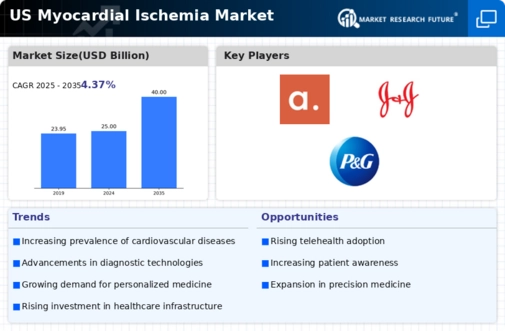Regulatory Support for Innovative Therapies
Regulatory bodies in the US are increasingly supporting the development of innovative therapies for myocardial ischemia, which is a crucial driver for the market. The FDA has implemented expedited review processes for breakthrough therapies, allowing for faster access to new treatments. This regulatory environment encourages pharmaceutical companies to invest in research and development, potentially leading to the introduction of novel therapies that address unmet medical needs. As a result, the myocardial ischemia market is likely to experience a surge in new product launches, enhancing treatment options for patients. The anticipated growth in this sector could reach $15 billion by 2027, reflecting the positive impact of regulatory support on market dynamics.
Rising Prevalence of Cardiovascular Diseases
The increasing incidence of cardiovascular diseases in the US is a primary driver for the myocardial ischemia market. According to the American Heart Association, nearly 697,000 individuals die from heart disease annually, highlighting the urgent need for effective diagnostic and therapeutic solutions. This alarming statistic suggests a growing patient population that requires management for myocardial ischemia, thereby propelling market growth. Furthermore, the aging population, which is more susceptible to heart conditions, is expected to contribute to a 20% increase in myocardial ischemia cases by 2030. As healthcare providers seek to address this rising burden, investments in innovative treatments and technologies are likely to surge, further stimulating the myocardial ischemia market.
Increased Awareness and Screening Initiatives
Growing awareness regarding heart health and the importance of early detection is driving the myocardial ischemia market. Public health campaigns and educational programs have led to a heightened understanding of risk factors associated with myocardial ischemia, prompting individuals to seek screening and preventive measures. The US government has invested approximately $1 billion in initiatives aimed at reducing cardiovascular disease mortality, which includes promoting screening for ischemic heart conditions. This proactive approach is likely to result in earlier diagnosis and treatment, thereby expanding the market for myocardial ischemia-related products and services. As awareness continues to rise, the demand for diagnostic tools and therapeutic interventions is expected to increase.
Technological Innovations in Treatment Options
Technological advancements in treatment modalities are significantly influencing the myocardial ischemia market. The introduction of minimally invasive procedures, such as percutaneous coronary interventions, has transformed patient care, offering quicker recovery times and reduced hospital stays. Additionally, the development of novel pharmacological agents, including antiplatelet and anticoagulant therapies, has improved patient outcomes. The market for these innovative treatments is projected to reach $12 billion by 2026, reflecting a robust demand for effective solutions. As healthcare systems increasingly adopt these technologies, the myocardial ischemia market is poised for substantial growth, driven by the need for enhanced treatment efficacy and patient satisfaction.
Growing Investment in Healthcare Infrastructure
The expansion of healthcare infrastructure in the US is a significant driver for the myocardial ischemia market. Increased funding for hospitals and clinics, particularly in underserved areas, is enhancing access to cardiovascular care. The US government has allocated over $50 billion to improve healthcare facilities, which includes upgrading diagnostic and treatment capabilities for myocardial ischemia. This investment is expected to facilitate the adoption of advanced technologies and therapies, ultimately improving patient outcomes. As healthcare systems evolve to meet the rising demand for cardiovascular services, the myocardial ischemia market is likely to benefit from enhanced service delivery and increased patient engagement.














Leave a Comment